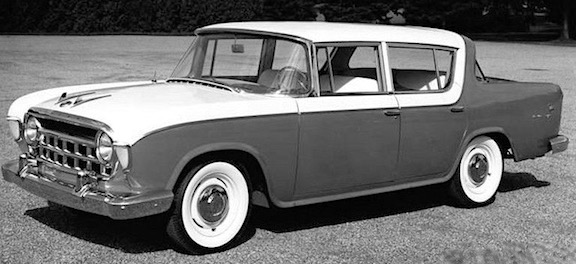The
Nash Rambler, launched during the 1950 model year was the most successful American postwar "compact" car. Not so successful were the early 1950s Henry J from Kaiser, the Aero Willys and the Hudson Jet.
Eventually, a redesign was called for, resulting in the 1956
Rambler from American Motors Corporation (AMC, created by a merger of Nash and Hudson in the spring of 1954). Ramblers for the 1955-56 model years were badged as either Nash Rambler or Hudson Rambler. Beginning in 1957, Rambler became a distinct brand.
Given the lead-time required for the creation and production of a new design, it seems likely that styling of the 1956 Rambler line was started before AMC was created.
Edmund Anderson, a veteran of General Motors, joined Nash in 1950 and was responsible for Nash and AMC styling until his departure in 1961.
The previous link suggests that Anderson might have been more an administrator than designer, but was good at hiring talented stylists. Whatever the design situation was at Nash and AMC in roughly 1952-55, the resulting Rambler was an odd-looking car both in the context of its times and even today.
Unless noted, the images below are either factory-derived photos or are pictures of cars listed for sale.
Gallery
Setting the scene -- a four-door 1955 Rambler sedan.
And a 1955 Rambler station wagon. Its roofline theme was carried over to the 1956 redesign.
1956 Rambler 4-door hardtop. This design was significantly longer than previous Nash Ramblers. Its windshield is panoramic/wraparound in line with mid-1950s American styling fashion. The three-color paint scheme (usually black, white and an accent color) was also fashionable.
Front view. Headlights were set inside the grille frame, a feature found on 1955 and 1956 Nash full-size cars. I find this ensemble awkward, even incoherent. Perhaps a better solution using the same elements would place the vertical bars in the upper two levels, leaving the lower level blank.
Quasi-side view. The panoramic windshield design seems cramped, ungraceful. The dominant feature is the heavy C-pillar that is over-emphasized by having two colors pass over it. This paint scheme does relate somewhat to body elements, but mostly serves to disguise them. I suspect that the general form of the passenger compartment "greenhouse" was strongly influenced by engineering, rather than styling, considerations.
This isn't the best possible view of the rear end, but it was the best I could find at the time. It is a four-door sedan -- note the full-height B-pillar. The various details work together poorly for the most part.
Alternative three-color side trim for "Sedan Custom" model. Apparently the wrap-over-the-C-pillar paint scheme was criticized by potential buyers, so this revised pattern was offered. It is an improvement, and the wrap-over was only offered for 1956 Ramblers.
Rambler "Super" with its simplified two-color paint scheme. It too has that wrap-over, but provides us a better feeling for the body design. Besides the awkward grille design mentioned above, an improvement would have been to eliminate the panoramic windshield, replacing it with a conventional A-pillar (though that might have been risky from a marketing standpoint at the time).
1956 Rambler Cross Country station wagon, hardtop (pillarless) version. The stepped aft roofline is a carryover from the previous Rambler design: compare to the second image from the top.
Barrett-Jackson auction photo showing the station wagon's rear.
The 1956 Rambler's design is something of a mystery to me. Anderson and his staff were competent, yet the cars were not attractive: Why? I suggested above that engineering considerations and styling fashions might have been factors. Another possible factor was the need (as seen by Nash president George Mason) for Ramblers to be distinct from normal American styling and design practice. This was true of his original compact Nash Rambler that was first offered as a well-equipped convertible rather than a stripped-down compact sedan. The first Ramblers were reasonably successful in the marketplace, and so was the design discussed here. Apparently beauty isn't always everything.



















































